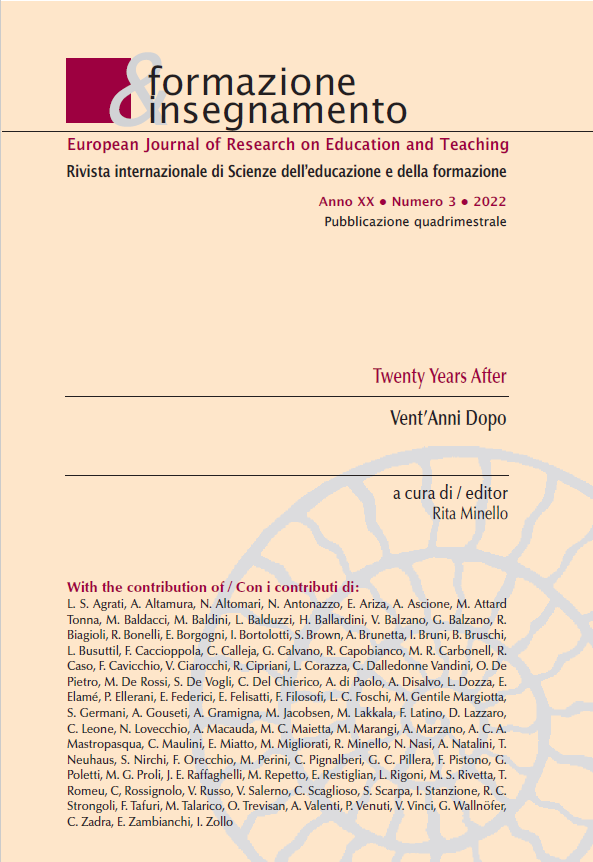Supporting the professional growth of educators through video analysis: A research conducted in Trento’s preschools
DOI:
https://doi.org/10.7346/-fei-XX-03-22_17Keywords:
Video analysis, In-service training, Observational skills, Reflexivity, Inclusive educational settingsAbstract
In this paper we will present a two-year training project, conducted in two kindergartens in the province of Trento, in which video-analysis was used as a training tool aimed at supporting and accompanying the professional growth of educators. In order to support an intentional and conscious process of didactic innovation, the training set out to work on the development of observational and reflective skills that would enable the educators to maintain a continuous dialogue between the pedagogical theories and daily educational practices. Through the analysis of video-frames depicting children's learning experiences, it is possible to reflect not only on “what” educators propose to children but especially on “how” they do it, in order to understand what relational and communicative ways of negotiating and co-constructing, together with children, the delicate balance between support and autonomy and between care and education.
References
Ahn, H. J. (2010). Examining conceptions of volunteering in early childhood education from diverse perspectives. Korean Journal of Human Ecology, 19(3), 471–485. https://doi.org/10.5934/KJHE.2010.19.3.471
Balduzzi, L. (2021), Pronti per cosa? Innovare i servizi e la scuola dell’infanzia a partire dalle pratiche di continuità educativa. FrancoAngeli: Milano.
Balduzzi, L., Dalledonne Vandini, C. (2021). Sostenere lo sviluppo della professionalità nei servizi per la prima infanzia: riflessioni tratte dal progetto TRACKs. Nuova Secondaria, 37, pp. 333–335.
Balduzzi, L., Tutone L. (2021). Ripensare spazi, tempi e raggruppamenti oltre le bolle: l’eterogeneità come risorsa per la socializzazione e l’apprendimento. In L. Balduzzi, & A. Lazzari (Eds.), Ripartire dall'infanzia. Esperienze e riflessioni nei servizi zero-sei in prospettiva post-pandemica (pp. 33–60). Parma: Junior.
Balduzzi, L., Migliarini, V., & Lazzari, A. (2019). Keeping TRACK(s) of inclusive interactions in ECEC services: the affordances of video-analysis for professional development. Form@re - Open Journal Per La Formazione in Rete, 19(3), 138-154. https://doi.org/10.13128/form-7714
Bateman, A. (2017). Hearing children’s voices through a conversation analysis approach. International Journal of Early Years Education, 25(3), 241–256. https://doi.org/10.1080/09669760.2017.1344624
Bateman, A. (2021). Teacher responses to toddler crying in the New Zealand outdoor environment. Journal of Pragmatics, 175, 81-93. https://doi.org/10.1016/j.pragma.2021.01.014
Berger, P. L., Luckmann, T., & Innocenti, M. S. (1969). La realtà come costruzione sociale. Bologna: Il mulino.
Bertolini, P. (1988). L’esistere pedagogico. Ragioni e limiti di una pedagogia come scienza fenomenologicamente fondata. Firenze: La Nuova Italia
Bondioli, A. (2000). Manuale di valutazione del contest. Milano: FrancoAngeli.
Burdelski, M. (2013). “I’m sorry, flower”: Socializing apology, relationships, and empathy in Japan. Pragmatics and Society, 4(1), 54–81. https://doi.org/10.1075/ps.4.1.03bur
Cekaite, A. (2017). What makes a child a good language learner? interactional competence, identity, and immersion in a Swedish classroom. Annual Review of Applied Linguistics, 37, 45–61. https://doi.org/10.1017/S0267190517000046
Cekaite, A., & Holm Kvist, M. (2017). The comforting touch: Tactile intimacy and talk in managing children’s distress. Research on Language and Social Interaction, 50(2), 109–127. https://doi.org/10.1080/08351813.2017.1301293
Cekaite, A., & Bergnehr, D. (2018). Affectionate touch and care: Embodied intimacy, compassion and control in early childhood education. European Early Childhood Education Research Journal, 26(6), 940–955. https://doi.org/10.1080/1350293X.2018.1533710
Craven, A., & Potter, J. (2010). Directives: Entitlement and contingency in action. Discourse Studies, 12(4), 419–442. https://doi.org/10.1177/1461445610370126
Fukkink, R., Jilink, L., Op den Kelder, R., Zeijlmans, K., Bollen, I., & Koopman, L. (2019). The development of interaction skills in preservice teacher education: A mixed-methods study of Dutch pre-service teachers. Early Childhood Education Journal, 47(3), 321–329. https://doi.org/10.1007/s10643-019-00927-7
Gariboldi, A. (2007). Valutare il curricolo implicito nella scuola dell’infanzia. Edizioni Junior: Parma.
Goodwin, C. (1994). Professional vision. American anthropologist, 96(3), 606–633. Retrieved September 30, 2022, from https://www.jstor.org/stable/682303
Hertenstein, M. J., Holmes, R., McCullough, M., & Keltner, D. (2009). The communication of emotion via touch. Emotion, 9(4), 566. https://doi.org/10.1037/a0016108
Holm Kvist, M. (2018). Children’s crying in play conflicts: A locus for moral and emotional socialization. In Research on children and social interaction, 2(2). https://doi.org/10.1558/rcsi.37386
Noddings, N. (2013). Caring: A relational approach to ethics and moral education. Berkeley, CA and Los Angeles: University of California Press. Retrieved September 30, 2022, from https://www.jstor.org/stable/10.1525/j.ctt7zw1nb
Page, J., & Elfer, P. (2013). The emotional complexity of attachment interactions in nursery. European Early Childhood Education Research Journal, 21(4), 553–567. https://doi.org/10.1080/1350293X.2013.766032
Peleman, B., Lazzari, A., Budginaitė, I., Siarova, H., Hauari, H., Peeters, J., & Cameron, C. (2018). Continuous professional development and ECEC quality: Findings from a European systematic literature review. European Journal of Education, 53(1), 9–22. https://doi.org/10.1111/ejed.12257
Santagata, R., & Guarino, J. (2011). Using video to teach future teachers to learn from teaching. Zdm, 43(1), 133–145. https://doi.org/10.1007/s11858-010-0292-3
Theobald, M. (2019). UN Convention on the Rights of the Child: “Where are we at in recognising children’s rights in early childhood, three decades on…?”. International Journal of Early Childhood, 51(3), 251–257. https://doi.org/10.1007/s13158-019-00258-z
Tobin, J. J., Mantovani, S., & Bove, C. (2010). Methodological issues in vide-based research on immigrant children and parents in early childhood settings. In L. Mortari & M. Tarozzi (Eds.), Phenomenology and Human Science Research Today (pp. 204–225). https://doi.org/10.7761/9789731997452_8
Thompson, I., Willemse, M., Mutton, T., Burn, K., & De Bruïne, E. (2018). Teacher education and family–school partnerships in different contexts: A cross country analysis of national teacher education frameworks across a range of European countries. Journal of Education for Teaching, 44(3), 258-277. https://doi.org/10.1080/02607476.2018.1465621
van Es, E. A., & Sherin, M. G. (2008). Mathematics teachers’ “learning to notice” in the context of a video club. Teaching and teacher education, 24(2), 244–276. https://doi.org/10.1016/j.tate.2006.11.005
Vygotsky, L. (1962). Thinking and Speaking. Cambridge (MA): MIT Press.
Zanelli, P., Marcuccio, M., & Maselli, M. (2017). Sfondo educativo, inclusione, apprendimenti. Bergamo: ZeroseiUp.
Downloads
Published
How to Cite
Issue
Section
License
Copyright (c) 2022 Chiara Dalledonne Vandini, Lucia Balduzzi

This work is licensed under a Creative Commons Attribution 4.0 International License.
Formazione & insegnamento is distributed under Attribution 4.0 International (CC BY 4.0).
For further details, please refer to our Repository & Archiving Policy, as well as our Copyright & Licensing Terms.





